Last Friday my good friend Maura invited me to go see the Art of Storytelling exhibit at the American Visionary Art Museum here in Baltimore.
I'm going to have to go back because I spent the entire time I was there absorbing the embroidered story of Esther Krinitz.
I had seen Esther's embroideries many years ago and have never forgotten their power.
Seeing them for a second time, I was able to move beyond the "what" of the story and focus more on how her story was told.
Esther grew up in a small town in Holocaust Poland where she saw her family terrorized by Nazis and eventually forced to leave their homes and march to their deaths. At fifteen years of age, Esther together with her 13-year old sister, Mania, separated from her family in a desparate attempt at survival. They sought refuge from townspeople and a family friend, but were constantly pursued by Nazis who were seeking them out.
Esther embroidered her story in 36 panels, many with captions helping to tell her tale of survival.
As I studied her story for the second time, I realized how the format that she had chosen for telling her story...needle, thread and fabric...helped to soften the horror of the events that happened to her and her family. It made her story more digestible.
And I felt how she had used the many, many hours of stitching to honor and memorialize all those in her family whom she had lost.
And, as Esther shared her personal horror story, she never failed to incorporate plants, flowers, trees and other plant/animal life. It is amazing to me that she had the capacity to remember the beauty that surrounded the atrocities that were committed against her and her family.

©Bernice Steinhardt & Helene McQuade
To Esther, nature gave her refuge, solace and nourishment. When she was hungry, she found food there. When she had no place to hide and the friends and neighbors she had known could no longer protect her, the forest gave her safe haven.
©Bernice Steinhardt & Helene McQuade

©Bernice Steinhardt & Helene McQuade
©Bernice Steinhardt & Helene McQuade
Later, I watched the award-winning documentary titled Through the Eye of the Needle: The Art of Esther Nisenthal Krinitz. In that movie, a psychiatrist stated that this was a pivotal moment in Esther's life because her mother was giving Esther permission to survive. This permission would help define Esther and guide her actions as she evaded capture and death.
I loved how she stitched the flowers up and over the skirts so you could almost feel like the field was alive and actively working to conceal the girls.
The story, as sewn and revealed by Esther, is captivating, compelling and, at times, charming. If you have the opportunity to view the exhibit one day, I highly recommend it. You can view the traveling exhibit schedule here.
And if you cannot, might I recommend that you visit the Gallery at the Art & Remembrance website where you can view all her embroideries. The pictures are in high-resolution so you can click twice and feast your eyes on all the details. Also, turn up the volume on your computer...many of the slides are narrated by her daughters.
Though Ester was an accomplished sewer, she had no formal art training. She told her stories to her two daughters and wrote in many journals but she wanted them to be able to see pictures of her memories. It wasn't until she was 50 years old that she began using embroidery to translate her story. She hesitated to begin because she felt she could not draw. She asked her daughter Helene to draw a picture of her childhood home. Her daughter responded, "But, Mom. I don't know what your house looked like! You'll have to do this yourself."

©Bernice Steinhardt & Helene McQuade
Esther died in 2001 at the age of 74. Her daughters continue to share her pictures, and encourage other youth to use art to express their feelings.
There's a picture book of the exhibit titled Memories of Survival
Happy Thanksgiving to all of you. I am so grateful for this wonderful internet that allows us to share our friendship and love of needlework.
See you next Monday. xoxo







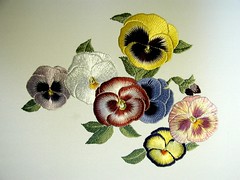
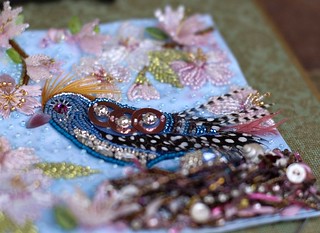
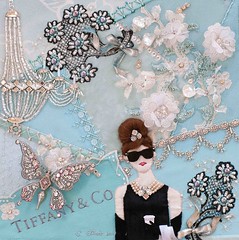
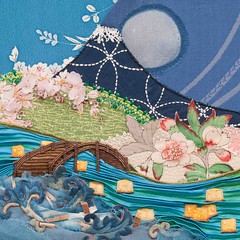
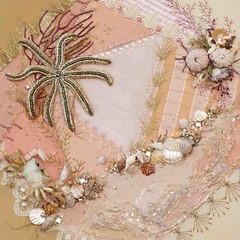












19 comments:
I find it hard to express what I felt and still feel after reading your blog. An amazing story and I do so hope it will do a world wide tour as they deserve to be seen and read about everywhere. Thank you for sharing such a tragedy of a family`s destruction and how Ester came through it with us,
I'd never even heard of Esther, but having read your post, I do hope her work comes to the UK so I can see it for myseff.
When i count my friends to be thankful for, you are certainly one of them., Your blog is always a wonderful stop on my visit list. Thank you for telling us of this wonderful lady and her work. Thank you for being you!
Susan, This is astounding. Simply astounding. This holding together horror and beauty - it's one of the highest callings and greatest tasks of human beings, I think. I am sharing this on facebook and twitter because more people need to look at these beautiful, beautiful pieces and read your good words about them. I think it is significant that she waited many years to do this. She lived with the truth of it all and processed it in lots of different ways - and looks what glory came out. Remarkable. Thank you so much.
We are so fortunate to have her story and her beautiful art work. The power of art to heal, transform and inform is truly amazing. Thank you for sharing her story. I am going to order the book and dvd . I hope to see her story in person one day.
An amazing story! Thank you so much for sharing it!
Oh, Susan. Thank you so very much for sharing this on your blog. You have made me cry.....in a good way.
Thank you so much for sharing this incredibly moving exhibit. I ordered a copy of the DVD and I plan to watch it and share it with my needlework friends.
What a wonderful thanksgiving day post!
I was so fortunate to have seen this unbelievable exhibit when it appeared at the Jewish Museum in Berkeley CA several years ago. Viewing it was so emotional that my friend and I found it difficult to talk about it afterward. It is a very profound experience that I hope all of your online readers have the opportunity to experience one day.
What an amazing story and thank you Susan for sharing in the lovely way that you do. Those panels are a lovely way for Esther to express herself and to show us the trials that people go through during times of war and hatred. A lovely legacy for her family.
I have never heard of Esther. Its a truly amazing and artistic way of sharing her life story; an important story for the world to know and remember.
Terry and I watched an all day documentary a few weeks ago Sunday on the History Channel about Hitler and the Nazi history. There is so much to know that you wouldn't without these documentaries and the stories that those have lived through it tell.
Thanks for sharing all the links too.
xx, Carol
Thanks for sharing these great photos, Susan. What amazing pieces! They look like some include applique? We sang with our choir on the railroad tracks in Auschwitz, an experience that still leaves a lump in my throat. What an evil place!
Thank you so much for educating me on this most fascinating story.
What an amazing story. Thank you for sharing.
Hi, Susan. Great post, amazing story, and wonderful embroidery. I had never heard of Esther before. Very exciting work. And have a happy holiday season with lots of stitching!
best, nadia
Beautiful written Susan! Thanks so much for sharing these amazing works.
Can't wait to get to the web sight and see more! Thx for sharing.
Thank you for sharing, Susan. These embroideries are really amazing. I think I wil buy the book.
What a wonderful story and amazing embroideries, thank you for sharing, Susan. I think I will buy the book.
Post a Comment